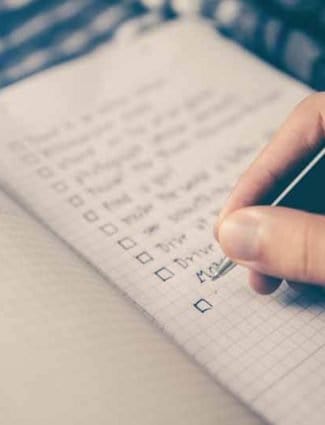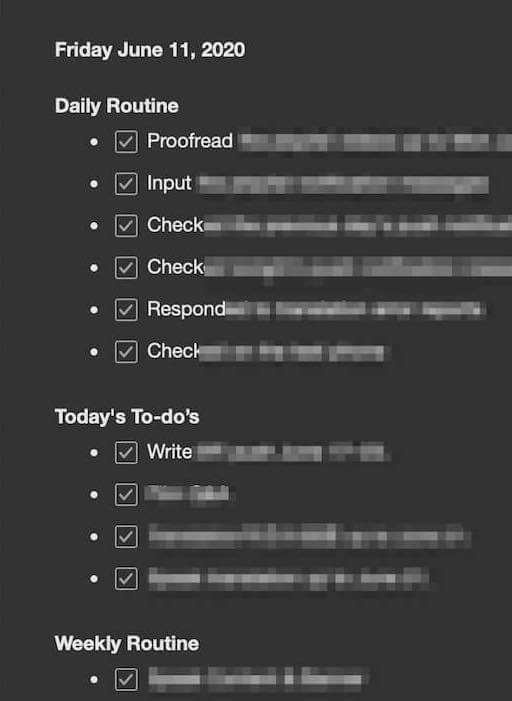Simple Checklist System for
Finishing Work Guilt-Free

In this post, you’re going to learn a simple but powerful checklist system I use to get things done and close a workday guilt-free.
When you work from home, sometimes there’s no clear divide between work and life.
This checklist system will fix that.
Working from home can be stressful.
All the distractions at home can lower productivity. Or, you might end up being a workaholic because you constantly worry about your work especially when your living space and workspace are the same.
There was a clear divide between life and work when you had an office commute. But now you don’t. I’m guilty of this and I used to find myself compulsively checking my work email before going to bed. No wonder I have a dream about working and responding to work email. Ugh.
I wanted to get everything I needed to be done in a day. But I also wanted to stop checking email or worrying about work after 6 p.m. I wanted to clear my mind before and after the work hour, even when I’m working from. I wanted to stop feeling guilty when I was not working. It was so tempting to check the work email and worry about the progress status of the projects I’m involved with.
I started to implement a simple daily checklist system, and it’s working great for me.
After implementing a checklist system, I know exactly what needs to be done and I get them done every day. I also stopped worrying about work and I am able to completely clear my mind after the workhour and on the weekend. I am no longer tempted to check my work email.
Here’s how it works.
Create a templatized daily checklist and putting a date on it. The checklist constitutes of the following “buckets”:
- Daily Routine
- Today’s To-do’s
- Tomorrow’s To-do’s
- Weekly Routine
- Later

Daily Routine
“Daily routine” is self-explanatory. They are tasks that need to be done on a regular basis. These tasks can be actions that you take to ease into your work when your focus muscle hasn’t really kicked in yet. You can do them during your downtime or during the slump after lunch. Daily routine tasks are non-urgent but important tasks. They might be administrative tasks that don’t require much of your brainpower. For me at my current job, those tasks include translation, checking some stats, and ensuring the delivery of the mobile push notification messages. They’re non-negotiable tasks that need to be checked off every day.
Today’s To-do’s
These are the tasks I want to or I am being held accountable to get done today. The tasks with a high priority are marked and I try to get them done earlier in the day as much as possible. I track my task completion duration so that I can manage my time in a day and prioritize my tasks accordingly. Granted, sometimes I misjudge the time for task completion or unexpected things happen in a day. In those events, I move the low priority tasks to “Tomorrow’s To-do’s.”
Tomorrow’s To-do’s
As I’m working throughout the day, things come up. Someone sends me an email requesting me to perform a task that requires me to do some research before sending a reply. If it isn’t too urgent, I’d then write to them in my “Tomorrow’s To-do’s” as they come. I might also reorganize my tasks during the day and move some tasks from other buckets to “Tomorrow’s To-do’s.”
Weekly Routine
This could be a weekly, biweekly, or monthly routine depending on your work, but I have a set of weekly tasks that I perform usually on Friday. I keep the weekly routine tasks in its own bucket so as not to forget when I decide to take a day off in a week, especially on Friday.
Later
Any incoming inquiries or tasks that are low priority or might take me a little longer than a week are put into the “Later” bucket. This bucket inevitably has the longest list and I frequently organize the tasks within this bucket.
How to use this daily checklist
The tasks in these buckets are listed vertically on a single Evernote note. Each page gets its own date, and every morning I generate a new Evernote note with these buckets and lists.
When you start a workday, create a copy from the template or yesterday’s checklist and put today’s date on it. Reorganize the tasks into appropriate “buckets” as necessary.
At the end of your workday, make sure all the items in “Daily Routine” and the priority items in “Today’s To-do’s” are checked.
Then write out any and every foreseeable task that you need to perform tomorrow onward. After writing them down, reorganize them into appropriate buckets. This way, your mind is freed from the obligation after you work, knowing that those tasks can wait and you’ll be ready to tackle them the next day.
I also have a separate Evernote note titled “Abandoned” where I put the project ideas that were abandoned. Sometimes when I’m stuck finishing a task I might refer to this note to see if I can draw some ideas.
Do you use a checklist?
When you’re involved with so many projects, coworkers, and stakeholders that are intertwined, and it can feel messy. You might feel that you don’t have the time to even create and maintain a checklist.
I don’t trust that my brain can hold everything in memory. For me, even at really busy times, a checklist works.
There are many systems out there but this is what’s working for me right now, without the system itself to be too overwhelming.
Among many to-do list apps, I prefer to use Evernote for this type of checklist because it’s one of the most flexible and simplest apps out there. I want the app to adapt to my checklist system, instead of my having to adapt my workflow to some app’s particular features.
Do you use a checklist? What kind of system works for you?
Join the Newsletter FREE
Get Exclusive Productivity Tips That I Only Share with Subscribers

